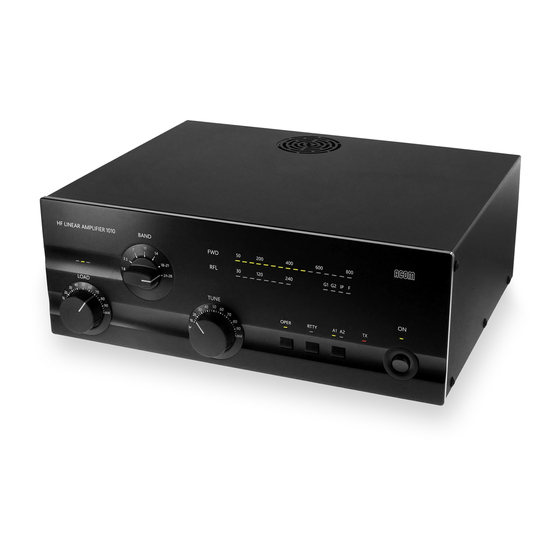Acom 1011 Manual de instruções - Página 16
Procurar online ou descarregar pdf Manual de instruções para Amplificador linear Acom 1011. Acom 1011 19 páginas. Hf linear amplifier

The two primary line (mains) fuses in the amplifier are located on the rear panel (Fig. 2-1). They are of
the fast (quick blow) type, European size 5 x 20 mm. Use 10 A for 100-120 V ac operation; 6.3 A for
200-240 V ac operation. Suitable types are:
For 120 V: 10 A 250 V 5 x 20 mm fast (quick blow), LITTELFUSE 0217010; Wickmann 1942100000
For 240 V: 6.3 A 250 V 5 x 20 mm fast (quick blow), LITTELFUSE 021706.3; Wickmann 1931630000
Besides the primary fuses, there are also fuses located on the HV PCB and on the MAINS PCB (inside
the amplifier). They are European size 5 x 20 mm, 0.8 A, 2 A and 5 A, time lag (slow-blow) type.
Suitable types are:
HV PCB: 2 A 250 V SLOW BLOW (Time Lag) 5 x 20 mm; LITTELFUSE 0218002; Wickmann
1951200000
MAINS PCB: 5 A 250 V SLOW BLOW (Time Lag) 5 x 20 mm; LITTELFUSE 0218005; Wickmann
1951500000
MAINS PCB: 0.8 A 250 V SLOW BLOW (Time Lag) 5 x 20 mm; BUSSMANN type S504-800mA
These latter fuses must not be replaced by the user. Replacing these internal fuses is potentially dangerous
and must be done only by a trained service technician. Contact your ACOM dealer for assistance.
5-3. Tubes Replacement
Two 4CX250B (7203) ceramic-metal tetrodes are used in the amplifier. The new tubes must be supplied
as a Matched Pair with close electrical characteristics. Replacement is a complex and potentially dangerous
operation that involves adjustment of the plate idling current. This should not be attempted by the user.
Contact your ACOM dealer.
5-4. Simplified Schematic Diagram
See Fig. 5-1 ACOM1011 Simplified* Schematic Diagram. The two 4CX250B (7203) ceramic-metal
tetrodes (V1 and V2) with a total plate dissipation of 500W (forced air cooling) are grid-driven. The input
signal from the RF INPUT jack is passed through a broadband input matching circuit, which consists
of components on the INPUT PCB and includes the drive-power swamping resistor Rsw. This circuit
tunes out the input capacitance of the tubes. The swamping resistor Rsw is a termination load for the
matching circuit and can dissipate up to 80 W of RF drive power. It also eliminates any tendency toward
oscillation by the tubes, ensuring excellent RF stability of the amplifier.
The cathode resistors Rc1 and Rc2 create DC and RF negative feedback, thus stabilizing gain and equalizing
frequency response. The combinations Lp1-Rp1 and Lp2-Rp2 in the plate circuits are VHF/UHF parasitic
suppressors. DC plate voltage is fed through chokes RFC1-RFC2 and the capacitor Cb3 blocks it from
the output. The output tank, comprised of LP1, LP2, LL, CP1-CP3, and CL1-CL4 , forms a classic Pi-L
network and suppress harmonic frequency emissions. This circuit is switched and tuned by S1A-S1C
and the air variable capacitors CP1, 2 and CL1, 2. The output signal is fed through the antenna relays K1
and K2 in the WATTMETER PCB. The WATTMETER PCB also includes a high-pass filter for frequencies
below 100 kHz, and it prevents the plate supply from reaching the antenna.
The plate RF voltage is monitored through the capacitor Ca and together with the RF WATTMETER is
the main source of information for the control circuit of the amplifier in evaluating tuning quality. The
control circuit is based on the ATMEGA-8L micro-controller from Atmel. All voltages are delivered
from the line (MAINS) and HV PCBs. The currents of the control grids, screen grids, and the plates, as
15
